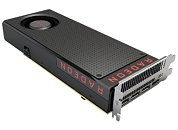Wednesday, August 17th 2016

High PCIe Slot Power Draw Costs RX 480 PCI-SIG Integrator Listing
AMD's design of the Radeon RX 480 graphics card, which draws over 75W of power from the PCI-Express x16 slot, has cost it a product listing on the PCI-SIG Integrators List. The list is compiled for hardware devices implementing the various PCI-Express specifications to the letter. The RX 480 is off-spec, in that it overdraws power from the slot, as the card needs more power than what the slot and the 6-pin PCIe power connector can provide while staying within specs. According to these specs, the slot can provide up to 75W of power, and the 6-pin connector another 75W. The RX 480 was tested to draw more than this 150W power budget.
What this means for AMD is that it cannot display the PCI-Express certification logo on the product or its marketing materials. This, however, may not affect AMD's add-in board (AIB) partners that are PCI-SIG members in their own right, and make graphics cards with their own sub-vendor IDs, provided their power-supply designs comply with PCIe specs. Custom-design cards with an 8-pin PCIe power connector, instead of 6-pin, may qualify as the combination of the 8-pin connector and the slot yields a power budget of 225W. AMD released a software fix to the issue of the cards overdrawing power from the slot, with the Radeon Software Crimson Edition 16.7.1 Beta.
Source:
Heise.de
What this means for AMD is that it cannot display the PCI-Express certification logo on the product or its marketing materials. This, however, may not affect AMD's add-in board (AIB) partners that are PCI-SIG members in their own right, and make graphics cards with their own sub-vendor IDs, provided their power-supply designs comply with PCIe specs. Custom-design cards with an 8-pin PCIe power connector, instead of 6-pin, may qualify as the combination of the 8-pin connector and the slot yields a power budget of 225W. AMD released a software fix to the issue of the cards overdrawing power from the slot, with the Radeon Software Crimson Edition 16.7.1 Beta.

63 Comments on High PCIe Slot Power Draw Costs RX 480 PCI-SIG Integrator Listing
But yes, buy a Sapphire version instead, far better.
A bit like FE from Nvidia. AIB's can be cheaper and cool better.
Not a big deal, but since there's a spec, users should be made aware when someone goes astray. Otherwise the spec turns into a bunch of guidelines.
right.. spikes in the power draw don't count I imagine..
www.techpowerup.com/img/16-07-08/rx-480-pcie-fix-power.jpg
>we-tested-confirmed-works
it doesn't work at all
The reason for not putting the 8pin is 1. bad design not knowing the total power draw of a full card. or 2. it will look bad that their "medium" graphic card is needing one 8pin power connector when other brands are only using one 6 pin.
And yes with the fix it is still not compliant it is 75 Watt from the slot and 75watt from 6 pin, not 84Watt from the 6 pin.